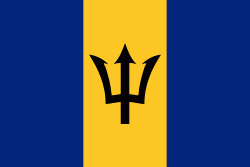Saint Andrew (Saint Andrew)
Saint Andrew ("St. Andrew") is one of eleven parishes of Barbados. It is situated in the northeastern area in the country.
Saint Andrew is one of the more unspoiled parts of the island owing to its physical makeup of green rolling hills. The parish of Saint Andrew also has the country's highest natural elevation, the 336 m Mount Hillaby at the southern part of the parish.
The parish is named after the patron saint, Saint Andrew, who is also the basis of the name for Barbados' former national award "The Order of Saint Andrew" and also the shape of the cross formed by two sugar cane stalks in the national Coat of Arms of Barbados.
During the colonial years under Britain, the British thought the area resembled the hills and fields of Scotland. This led to parts of the Parish of Saint Andrew today being nicknamed the "Scotland District". During the 1990s the Government of the time proposed a "Greenland Landfill" located within the parish. However, because of Saint Andrew's fragile environment and its possibility of future soil erosion the opening of the completed landfill has yet to come-about after almost a decade.
Saint Andrew lies on the eastern coastline of Barbados, where the Atlantic Ocean tends to be more turbulent. As part of Barbados' attempts to preserve the environment the parish is also home to several natural reserves including the Turner's Hall Woods.
Saint Andrew is one of the more unspoiled parts of the island owing to its physical makeup of green rolling hills. The parish of Saint Andrew also has the country's highest natural elevation, the 336 m Mount Hillaby at the southern part of the parish.
The parish is named after the patron saint, Saint Andrew, who is also the basis of the name for Barbados' former national award "The Order of Saint Andrew" and also the shape of the cross formed by two sugar cane stalks in the national Coat of Arms of Barbados.
During the colonial years under Britain, the British thought the area resembled the hills and fields of Scotland. This led to parts of the Parish of Saint Andrew today being nicknamed the "Scotland District". During the 1990s the Government of the time proposed a "Greenland Landfill" located within the parish. However, because of Saint Andrew's fragile environment and its possibility of future soil erosion the opening of the completed landfill has yet to come-about after almost a decade.
Saint Andrew lies on the eastern coastline of Barbados, where the Atlantic Ocean tends to be more turbulent. As part of Barbados' attempts to preserve the environment the parish is also home to several natural reserves including the Turner's Hall Woods.
Map - Saint Andrew (Saint Andrew)
Map
Country - Barbados
 |
 |
| Flag of Barbados | |
Inhabited by Kalinago people since the 13th century, and prior to that by other Amerindians, Spanish navigators took possession of Barbados in the late 15th century, claiming it for the Crown of Castile. It first appeared on a Spanish map in 1511. The Portuguese Empire claimed the island between 1532 and 1536, but abandoned it in 1620 with their only remnants being an introduction of wild boars for a good supply of meat whenever the island was visited. An English ship, the Olive Blossom, arrived in Barbados on 14 May 1625; its men took possession of the island in the name of King James I. In 1627, the first permanent settlers arrived from England, and Barbados became an English and later British colony. During this period, the colony operated on a plantation economy, relying on the labour of African slaves who worked on the island's plantations. Slavery continued until it was phased out through most of the British Empire by the Slavery Abolition Act 1833.
Currency / Language
| ISO | Currency | Symbol | Significant figures |
|---|---|---|---|
| BBD | Barbados dollar | $ | 2 |
| USD | United States dollar | $ | 2 |
| ISO | Language |
|---|---|
| EN | English language |















